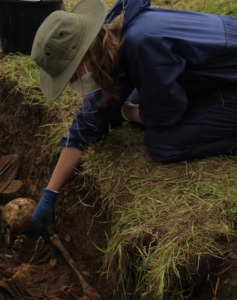From taxidermy to forensic investigation: My journey at Cranfield
13/03/2025

Christina Recheis completed her MSc in Forensic Investigation at Cranfield University in 2021 and specialised in forensic archaeology and anthropology. Her master’s thesis focused on developing an algorithm to facilitate the identification of human remains, reflecting her commitment to advancing forensic methodologies.
Here Christina shares her student journey at Cranfield to her career now working as a Terrestrial Project Archaeologist and what advice she’d give to new students.
Before starting my postgraduate journey at Cranfield University, I completed my undergraduate degree in Biology at the University of Innsbruck. Alongside my studies, I worked at a taxidermist, helping to curate a zoological and osteological collection. This hands-on experience sparked my interest in human remains and forensic science, ultimately leading me to pursue a career in forensic anthropology and archaeology.
I knew that gaining practical experience would be essential if I wanted to work in the field or secure a role in a forensic laboratory. That’s when I started looking into postgraduate study and found Cranfield University’s Forensic Investigation MSc. It offered exactly what I was looking for — a perfect blend of laboratory-based and fieldwork experiences.
Relocating to the UK for full-time study was a big step, but Cranfield’s course structure made the decision easy. The programme covers both forensic anthropology and archaeology, allowing students to shape their learning around their career goals. The brand-new Cranfield Forensic Institute (CFI) at the Bedford campus was also a huge selling point. Visiting the campus and meeting the lecturers confirmed my choice — their passion and expertise were exactly what I was hoping to learn from.

The Mass Fatality Incidents module at Cranfield was incredible and really opened my eyes to possible study areas, careers and networks of expert professionals.
The course itself exceeded my expectations. One of the standout modules was the mass fatality module — something I hadn’t considered before but turned out to be incredibly impactful. We heard from professionals with extensive field experience, which brought the learning to life. Additionally, having lecturers who have worked directly in forensic cases added a level of practical knowledge you just can’t get from textbooks.
Cranfield also offered plenty of hands-on learning. I particularly valued the practical modules, which allowed me to apply theoretical knowledge in real-world scenarios. Beyond that, I was fortunate to join with the CRICC group (Cranfield Recovery and Identification of Conflict Casualties), giving me the chance to continue fieldwork even after submitting my thesis. This experience was invaluable in shaping my career path.
Since graduating in 2021, I’ve gone on to work in a forensic laboratory and continue to collaborate with CRICC. My experiences and the network I built at Cranfield have opened doors I never imagined possible. Recently, I started working as a Terrestrial Project Archaeologist for the HJF, assisting the DPAA (Defense POW/MIA Accounting Agency) in recovering missing-in-action American soldiers from past conflicts. This role was a career goal of mine, and I genuinely believe my time at Cranfield played a major role in getting me here.

Getting to work in the field is exhausting, but an amazing experience Image © Harvey Mills
For anyone considering a career in forensic science, I can’t recommend this course enough. It’s ideal for those who want a practical, hands-on learning experience and aren’t quite sure which forensic path they want to follow. The broad range of modules helps you find your niche and build the skills you’ll need to succeed.
If you’re thinking about postgraduate study — do it. It’s hard work, but it pays off. Push yourself, say yes to every opportunity, and stay determined. The connections you make and the experience you gain could lead you to incredible career opportunities, just like it did for me.
Images courtesy of Cranfield University and Harvey Mills ©
Categories & Tags:
Leave a comment on this post:
You might also like…
Executive Insights: Studying Logistics and Supply Chain While Leading a Business
Q&A with Rory Comerford, Managing Director, Capcon Limited “I chose to study the part-time Executive Logistics and Supply Chain Management MSc at Cranfield to advance my career and gain a deeper understanding of this ...
Too much to do? Can’t get your thoughts down on paper?
Our Study Skills Hub has two sections that may be able to help you! In Time Management we have some great tips on how to manage your time, to prioritise, and de-stress. First of all, ...
How do I cite… quotations from video content in the APA7 style
When you quote from another source in your writing, you would traditionally include a page number in your in-text citation. But what do you do when there are no pages? How would you cite a ...
Using what you read in what you write – Summarising, paraphrasing and quoting other authors
University life involves a serious amount of reading and writing. We study the work of other people to inform ourselves about a topic. When we then re-use that knowledge to create our own work, we ...
Referencing in APA7: Using shortened URLs
As you may be aware, when you are referencing a website or any internet-based source you need to include the source URL. For most conventional reference lists, it is fine to include the URL or ...
Quarry Life and Cranfield Life
It might be thrilling to push yourself past your comfort zone, but it can also leave you feeling anxious and self-conscious. What if this is unsuccessful? What if I'm not as talented as I ...







